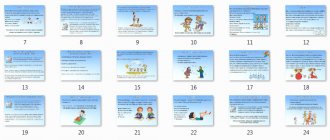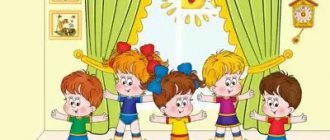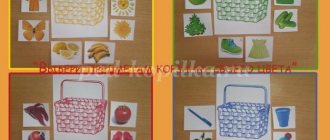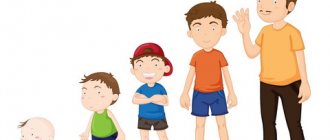Organization and conduct of outdoor games in kindergarten
Galina Volkova
Organization and conduct of outdoor games in kindergarten
Games occupy a large place in the life of a preschooler . (N.K. Krupskaya o.
Outdoor play is one of the important means of all-round development of children. It provides physical, mental, moral, and aesthetic education. Active motor activity of a gaming nature and the positive emotions it evokes enhance all physiological processes in the body , improve the functioning of all organs , and also develop physical qualities (speed, dexterity, accuracy, flexibility)
.
The game promotes the development of mutual assistance, collectivism, honesty, discipline, and promotes the development of strong-willed qualities (endurance, courage, determination, the ability to cope with negative emotions). In outdoor games, the child is given the right to decide for himself how to act in a given situation, to make his own choice to achieve a particular goal. Games help expand and deepen your understanding of the world around you and satisfy your curiosity.
The game is a way of splashing out accumulated energy, gaining new sensations, as well as a way of self-affirmation, etc. Outdoor games are divided into 2 groups :
Elementary - plot, plotless, fun games .
Difficult ones - football, small towns, volleyball, etc.
Thematic outdoor games are mainly played collectively . The actions of children in them are closely interconnected. Usually the main group portrays, for example, birds, bunnies, and one child becomes the performer of a responsible role - a wolf, a fox, a cat. The activity of the child playing the role of a wolf encourages all participants in the game to move faster and more energetically. When conducting plot-based outdoor games with children, you can use hats, elements of costumes, the costumes themselves, emphasizing the characteristics of the characters: cat, bear, wolf, rooster, etc. For other children taking part in the game as mice, birds, chickens, hats are not required . But if the game is held at a festive matinee or leisure evening, then hats can be put on all children to create a certain festive mood in them.
Plotless outdoor games are based on simple movements, there are no images in them, game actions are associated with the performance of a specific motor task.
Plotless games like "trap"
, dashes are very close to plot ones - they just don’t have images that children imitate; all other components are the same: the presence of rules, responsible roles, interconnected game actions of all participants.
These games , like the story ones, are based on simple movements, most often running combined with catching and hiding.
It should be taken into account that plotless games require more independence from children than plot-based games, speed and dexterity of movements, and better orientation in space. In the plotless games “Skittles”, “Ring Throw”, “Ball School”, children perform complex movements: throwing, throwing and catching. Preschool children are good at such movements. Such movements are used in game exercises “Hit the goal”, “Throw it higher”, etc. By practicing these actions, children gradually master the skills and abilities to operate with various objects (balls, balls, rings)
etc. They develop an eye, coordination of movements, and dexterity.
Fun games and attractions can be used for holidays, entertainment, or just to play during the day. The purpose of these games is to create a cheerful, joyful mood.
Complex outdoor games include a variety of sports games : football, basketball, hockey, etc. Elements of sports games play an important role in the comprehensive physical education of preschool children. They are selected taking into account the age, health status, individual inclinations and interests of the child. They use only some elements of sports game technology that are accessible and useful to preschool children. Based on these elements learned by children, games can be organized , which are played according to simplified rules.
Sports games strengthen large muscle groups and develop psychophysical qualities: strength, speed, agility, endurance. In sports games, a child’s mental activity and orientation in space increase, intelligence and quick thinking develop, and awareness of his own actions occurs. The child learns to coordinate his actions with the actions of his comrades; he develops restraint, self-control, responsibility, will and determination; His sensorimotor experience is enriched, creativity develops. Outdoor games with elements of sports games require special preparation of the child’s body to carry them out . To do this, in kindergarten it is necessary to use only those games that will give children the opportunity to quickly master the elements of sports games. To this end, the greatest attention should be paid to ball games. In these games, children will master the skills of catching, throwing, and throwing. Children should be taught games with elements of sports games gradually, moving from simple to complex. Training should begin with learning common techniques that are similar to a number of games. When learning elementary techniques of sports games, the greatest love (especially for boys)
uses the game of small towns, as well as
ball
games Methods of conducting outdoor games :
1. Selection of games. Games are selected in accordance with educational objectives. From the selection of gaming material, which determines many factors - these are the age characteristics of children, their development, physical fitness, the number of children and the conditions of the game ; when choosing a game, you need to take into account the form of the activity (occupation or holiday)
.
During the lesson, time is limited; during the holidays, mass games and attractions are held , in which children of different ages can take part. The choice of game directly depends on the venue ( hall, open area, winter
games ) .
When playing outdoors, it is necessary to take into account the weather conditions. The choice of game also depends on the availability of manuals and equipment.
Due to the lack of a component inventory and unsuccessful replacement of it, the game may be upset. Inventory must be prepared. Inventory should be colorful, bright, and noticeable in the game. An adult must prepare the environment and first think through the moments in the game that will arouse children’s interest. 2. Gathering children for a game. Children need to be lured:
First of all, you need to create an interest in the game in children. Then they will better understand its rules, perform movements more clearly, and experience emotional uplift. You can, for example, read poetry, sing a song on a relevant topic, show children objects and toys that they will encounter in the game. to lead to the game by asking questions or asking riddles. In particular, you can ask: “What did you draw today?”
Children, for example, will answer:
“Spring, the arrival of birds
.
“Very good,” says the teacher. Today we will play the game "Migration of Birds"
.
For children in the younger group, you can show a flag, a bunny, a bear and immediately ask: “Do you want to play with them?”
A short story read or told by the teacher immediately before the game also gives good results.
3. Explanation of the game .
It should be short, understandable, interesting and emotional.
In younger groups, the teacher places children in a circle. The explanation is made during the game . The teacher himself places and moves the children, tells them how to act, and is accompanied by a demonstration (“how a bunny jumps, “a car drives out”
).
There is no need to specifically learn the text; children will learn it during the game .
The teacher takes upon himself to play the main role, and then, when the kids get used to the game, he entrusts this role to the children themselves. In older groups, children are placed in a line, semicircle, flock and the explanation is consistent: the name of the game , content, emphasize the rules, distribute roles, distribute attributes, place the players and begin game actions.
If the game is complex, there is no need to give a detailed explanation, but it is better to do this: first explain the most important thing, and then, during the game , supplement the main story with specific details. When repeated, the rules are clarified .
If the game is familiar, you can involve the children themselves in the explanation or recall certain important points.
4. Distribution of roles
The successful implementation of the game largely depends on the successful distribution of roles, so it is important to take into account the characteristics of children: shy, sedentary ones cannot always cope with a responsible role, but brought to this; on the other hand, you cannot always assign responsible roles to the same children; it is desirable that everyone be able to fulfill these roles.
In games with young children, the teacher first takes on the leading role (for example, the cat in the game “Sparrows and the Cat”
). And only then, when the kids get used to the game, does he assign this role to the children themselves.
In the older group, the game is first explained, then roles are assigned and children are placed. If the game is played for the first time , then the teacher does it, and then the players themselves.
5. Guidance during the game .
The children's play activities are supervised by the teacher. Its role depends on the nature of the game , on the size and age of the group, on the behavior of the participants: the younger the children are, the more active the teacher is. When playing with younger children, he acts with them, often playing the main role. In the middle and senior groups, the teacher first also plays the main role himself, and then passes it on to the children. He participates in the game even when there is not enough bunk ( “Find yourself a mate”
) The teacher's direct participation in the game raises interest in it and makes it more emotional.
The teacher gives instructions both during the game and before its repetition, evaluates the actions and behavior of the children. However, you should not overuse instructions about the incorrect execution of movements: comments can reduce the positive emotions that arise during the game . It is better to give instructions in a positive form, maintaining a joyful mood, encouraging determination, dexterity, resourcefulness, initiative - all this makes children want to strictly follow the rules of the game . The teacher monitors the children’s actions and does not allow long-term static postures (squatting, standing on one leg, raising the arms forward, upward, which cause narrowing of the difficult cell and poor circulation), monitors the general condition and well-being of each child.
The teacher regulates physical activity, which should increase gradually. The load can be increased by changing the tempo of the movements.
6. End of the game , summing up .
Summing up the game should be done in an interesting way to make you want to achieve even better results next time.
Providing time and space for children's playconsultation
Providing time and space for children to play.
One of the reasons for the reduction of play in modern preschool education is the lack of free time and, accordingly, time for play. The daily routine is overloaded with educational activities and necessary routine moments (sleep, walks, food). At best, 30-40 minutes are left for the game in the afternoon, when parents already come for many preschoolers. It is clear that in this situation it is almost impossible to master gaming skills and develop a full-fledged game.
If we take into account that in different types of games social and communicative, and speech, and cognitive and physical development is carried out, the game can be given sufficient space not only in the second, but also in the first half of the day. Introducing younger children who do not know how to play to play and free play of well-playing children can be considered as forms of social, communicative and speech development of preschool children.
Different types of games can be organized during a walk, not only active ones, but also plot ones. Outdoor play has its own characteristics and differences from indoor play. Open space offers more active movement for children. Story play on the street requires shelter and often takes place in houses or on the veranda, where there are toys (dolls, strollers, cars and other props). One or another version of the house is present at many sites. This could be a classic house (log or plank), a gazebo or a children's playground, where elevated areas become homes. Play spaces can also be elements of a plant landscape: tall bushes, tree branches. It’s good if children have the opportunity to independently build or arrange houses.
In addition to the houses, story games can be played in the sandbox, where mostly director's games with small dolls, animals, and cars take place. For such games, the sides of the sandbox (or the table space in the gazebo) are actively used. The advantage of playing outside is the abundance of substitute items made from natural materials. Leaves, pebbles, and acorns often become food for dolls, animals, or cargo in transport games. Sticks and planks can become building materials. Children love to play near tree trunks or large cut frosts - these can become habitats for small creatures.
It should be noted that story play in the area is observed less frequently than other types of children's activities (physical activity, cognitive activity, etc.). This may be due, on the one hand, to the need for physical activity during a walk, and on the other hand, to the lack of adequate subject-spatial conditions on the site: there are not enough secluded places for privacy, a shortage of suitable toys. In the presence of such conditions and with the support of the teacher, the plot game (both role-playing and directing) can actively unfold during a walk.
In the group room you need to create an environment for various games. To develop free play activities of preschoolers, specially organized zones are created in each group.
A special place should be allocated for games with large building materials, so that children have the opportunity to preserve the completed building for some time. Toys should be arranged so that it is convenient for everyone to take them and put them away. From the first days of being in kindergarten, children use toys independently; The teacher teaches them to handle them carefully and put them back in their place. From time to time, the teacher looks through the toys with the children and selects what needs to be repaired; He does minor repairs himself with the help of his children.
In younger groups, it is most advisable to store toys so that they are in the child’s field of vision - in play corners: after all, a toy stimulates the baby’s play intention, so it should be visible and accessible.
In the middle and older groups there is no such need, since children select toys based on the intent of the game. But children must know what toys are in the group, where they are stored, and maintain appropriate order.
In older groups, toys can be arranged according to themes (for example, for playing hospital, mail, travel, astronauts, etc.). The presence of such ready-made kits, consisting of the most necessary toys, allows children to quickly develop the game and select additional gaming materials. Such a set of toys should be compiled by the teacher together with the children as the game develops, and given to children only in finished form. Children, together with the teacher, can make their own homemade toys.
A number of conditions contribute to the successful implementation of gaming activities and increasing the effectiveness of play development in preschoolers:
1. Free and voluntary inclusion of children in the game: not imposition of games, but involvement in it. Exclusion of games that are too gambling: for money and things, games that contain in their rules actions that violate generally accepted moral standards. In the game, humiliation of the dignity of its participants, including the losers, is unacceptable. Games should not be overly (overtly) educational and overly didactic: their content should not be intrusively didactic and should not contain too much information (dates, names, rules).
2. Children must understand well the meaning and content of the game, its rules, and the idea of each game role.
3. The game should have a positive impact on the development of the emotional-volitional, intellectual and rational-physical spheres of its participants. With the help of the organization of gaming technologies, children are given the social experience of playing (teaching gaming skills).
4. Sufficient time for play and the availability of those toys that help children realize their plans, i.e. creation of an object-game environment.
5. Timely change of the play environment, taking into account the enriching life and play experience of children and in accordance with their interests, mood, organization of non-overlapping areas of independent children's activity within the play area (intellectual, theatrical and play, creative, role-playing, construction and constructive and games with physical activity). This will allow children to simultaneously organize different types of games in accordance with their interests and plans, without interfering with each other. It is important to ensure accessibility to all elements of the developing subject-play environment, conditions of isolation (“I see, but do not interfere”), selection of games, toys, play equipment, and a place to organize the play environment.
In order for children to be brought up in games successfully, it is necessary to create appropriate conditions: allocate sufficient time to games, organize a comfortable, calm environment, and select toys.
The “Kindergarten Education Program” requires that children be given the opportunity to play at different times of the day: in the morning before breakfast, between breakfast and class, during a break between classes, during a walk, in the afternoon (taken from Childhood).
Games in the morning help create a cheerful, joyful mood for the children for the whole day. Everyone can take their favorite toy and team up with friends if they wish. Often children come to kindergarten with certain play intentions and continue the game they started the day before. Breakfast interrupts the game, but the guys return to it again after breakfast, during a break between classes. During this short period, it is advisable to start a new game, but it is necessary to give the players the opportunity to continue the unfinished construction and discuss the further course of the game. In this case, the nature of the upcoming lesson should be taken into account. Before physical education, quiet games are preferable, and if the activity requires a monotonous position, active games are desirable. For indoor games, time is allotted in the afternoon, and on the site - before lunch and in the evening. During these hours, children play story games, build buildings, organize dramatization games, outdoor and didactic games.
Of course, the traditional play time in kindergarten is the afternoon. At this time, children have every right to free play activities. It is necessary to emphasize the importance of children’s independent choice of objects and play partners.
A game is a zone of freedom where a child can and should choose partners, material and the nature of the game itself.





